UPES B.Tech Admissions 2026
Ranked #43 among Engineering colleges in India by NIRF | Highest Package 1.3 CR , 100% Placements
जेईई मेन सिलेबस 2026 वेटेज (JEE Main 2026 Syllabus Weightage in hindi) - जेईई मेन परीक्षा में सफलता के लिए जेईई मेन सिलेबस (JEE main syllabus in hindi) की जानकारी होनी आवश्यक होती है। जेईई मेन 2026 सिलेबस विद वेटेज पीडीएफ पिछले वर्ष के जेईई परीक्षा विश्लेषण के आधार पर तैयार किया गया है। उम्मीदवार जेईई मेन 2026 परीक्षा के लिए रणनीतिक रूप से तैयारी करने के लिए जेईई मेन के लिए अध्यायवार वेटेज का उपयोग कर सकते हैं। उम्मीदवारों को परीक्षा में अच्छी रैंक प्राप्त करने के लिए उच्च-वेटेज विषयों पर अधिक ध्यान देना चाहिए। जेईई मेन 2026 सिलेबस नेशनल टेस्टिंग एजेंसी (एनटीए) द्वारा आधिकारिक वेबसाइट jeemain.nta.nic.in पर जारी कर दिया गया है। जेईई मेन 2026 सिलेबस विद वेटेज पीडीएफ में सबसे महत्वपूर्ण विषयों और अध्यायों की सूची शामिल है जिन्हें जेईई मेन परीक्षा के लिए तैयार किया जाना चाहिए। प्राधिकरण द्वारा जेईई मेन आवेदन जारी कर दिया गया है। जेईई मेन सत्र 1 परीक्षा का आयोजन 21 जनवरी से 30 जनवरी के बीच किया जाएगा जबकि सत्र 2 का आयोजन 2 अप्रैल से 9 अप्रैल के बीच किया जाएगा।
संबंधित लिंक: जेईई मेन पिछले वर्ष के प्रश्न पत्र पीडीएफ डाउनलोड करें
ये भी पढ़ें: क्या जेईई मेन्स 2026 में कैलकुलेटर की अनुमति है?
This Story also Contains
.jpg)
जेईई मेन में शामिल होने वाले उम्मीदवार वेटेज के साथ जेईई मेन सिलेबस पीडीएफ (JEE main syllabus pdf in Hindi) के साथ देख सकते हैं कि किस अध्याय में प्रश्नों का वेटेज ज्यादा है और किसमें कम है। इसके अलावा, उम्मीदवार हाई-वेटेज वाले विषयों को जानने के बाद जेईई मेन पेपर की बेहतर तैयारी में सफल हो सकेंगे। वैसे तो जेईई मेन परीक्षा की तैयारी के लिए परीक्षा में आने वाला प्रत्येक विषय महत्वपूर्ण है। लेकिन, अपनी तैयारी और कमजोर विषयों पर फोकस करे हुए उम्मीदवार वेटेज के साथ पिछले वर्ष के जेईई मेन सिलेबस को भी देख परीक्षा उत्तीर्ण करने की रणनीति पर काम कर सकते हैं।
ये भी पढ़ें- जेईई मेन में कितने नंबर पर अच्छा कॉलेज मिलता है | एनआईटी में एडमिशन के लिए कितने मार्क्स चाहिए
अध्यायों को कवर करने के लिए, उम्मीदवारों को एनसीईआरटी 12वीं समाधान और एनसीईआरटी 11वीं समाधान का संदर्भ लेना चाहिए। उम्मीदवार यहां पिछले वर्ष के अध्याय-वार जेईई मेन्स सिलेबस (jee main syllabus in hindi) को वेटेज के साथ (chapter-wise JEE Mains syllabus with weightage in hindi) प्राप्त कर सकते हैं ताकि यह पता चल सके कि कौन से विषय और इकाइयाँ पूछी गई थीं। परीक्षा में अच्छा स्कोर करने के लिए उम्मीदवारों को सभी उच्च-वेटेज विषयों को कवर करने के लिए वेटेज के साथ जेईई मेन पाठ्यक्रम 2026 (syllabus of JEE Main with weightage 2026 in hindi) का विश्लेषण करना चाहिए। पूछे गए प्रश्नों के प्रकार और उच्च-वेटेज अध्याय और विषयों को जानने के लिए जेईई मेन के पिछले वर्षों के प्रश्नपत्रों (JEE Main previous years papers in hindi) को हल करने का सुझाव दिया जाता है।
जेईई मेन 2026 परीक्षा तिथि जानने के लिए क्लिक करें
उम्मीदवार नीचे दी गई तालिका से जेईई मेन्स भौतिकी पेपर 2026 के लिए सबसे अधिक वेटेज वाले अध्यायों की जांच कर सकते हैं। जेईई मेन्स में भौतिकी के वेटेज को समझने से उम्मीदवारों को अपनी तैयारी को प्रभावी ढंग से रणनीति बनाने में मदद मिल सकती है।
जेईई मेन्स भौतिकी 2026 के लिए सबसे अधिक वेटेज वाले अध्याय आधुनिक भौतिकी, ऊष्मा और ऊष्मागतिकी, प्रकाशिकी, विद्युत धारा और बहुत कुछ हैं। नीचे जेईई मेन्स में पिछले वर्ष के आधुनिक भौतिकी के वेटेज की जाँच करें।
जेईई मेन के लिए सबसे अधिक वेटेज वाले अध्याय नीचे उल्लिखित हैं:
टॉपिक | प्रश्नों की संख्या | अंक |
|---|---|---|
आधुनिक भौतिकी (Modern Physics) | 5 | 20 |
ताप एवं ऊष्मप्रवैगिकी (Heat and Thermodynamics) | 3 | 12 |
ऑप्टिक्स (Optics) | 3 | 12 |
विधुत धारा (Current Electricity) | 3 | 12 |
स्थिर विधुत (Electrostatics) | 3 | 12 |
चुम्बकीय (Magnetics) | 2 | 8 |
मात्रक, वीमा एवं सदिश (Unit, Dimension and Vector) | 1 | 4 |
गतिकी (Kinematics) | 1 | 4 |
गति के नियम (Laws of motion) | 1 | 4 |
कार्य, बल एवं ऊर्जा (Work, Power and Energy) | 1 | 4 |
द्रव्यमान केंद्र, आवेग-संवेग प्रमेय (Centre Of Mass, Impulse and Momentum) | 1 | 4 |
घूर्णन (Rotation) | 1 | 4 |
गुरुत्वाकर्षण (Gravitation) | 1 | 4 |
सरल आवर्त गति (Simple Harmonic Motion) | 1 | 4 |
ठोस एवं तरल पदार्थ (Solids and Fluids) | 1 | 4 |
तरंगे (Waves) | 1 | 4 |
विद्युत चुम्बकीय प्रेरण (Electromagnetics Induction ; AC) | 1 | 4 |
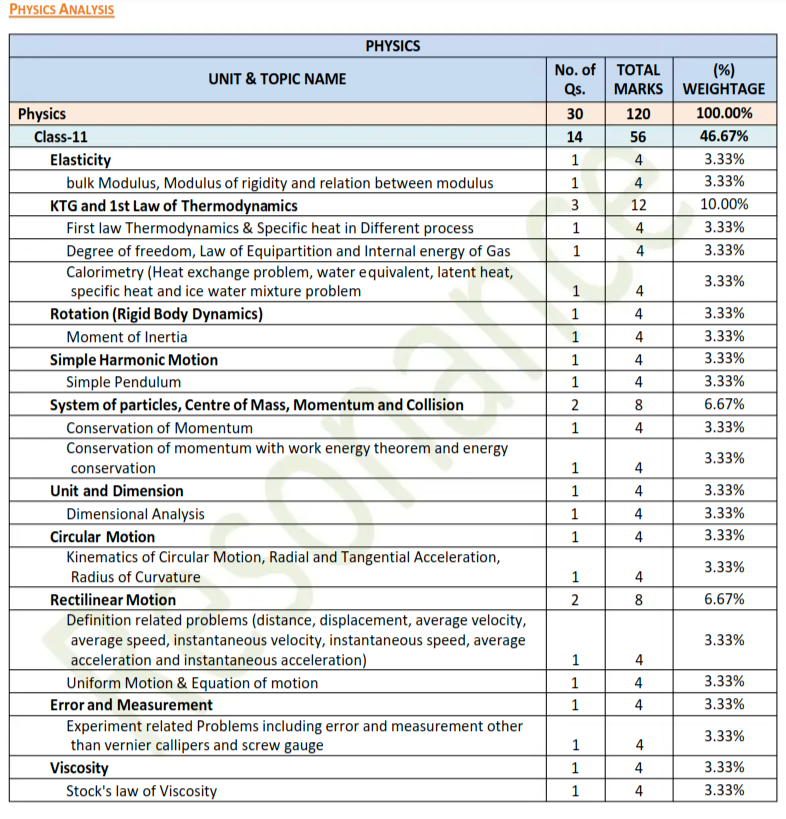
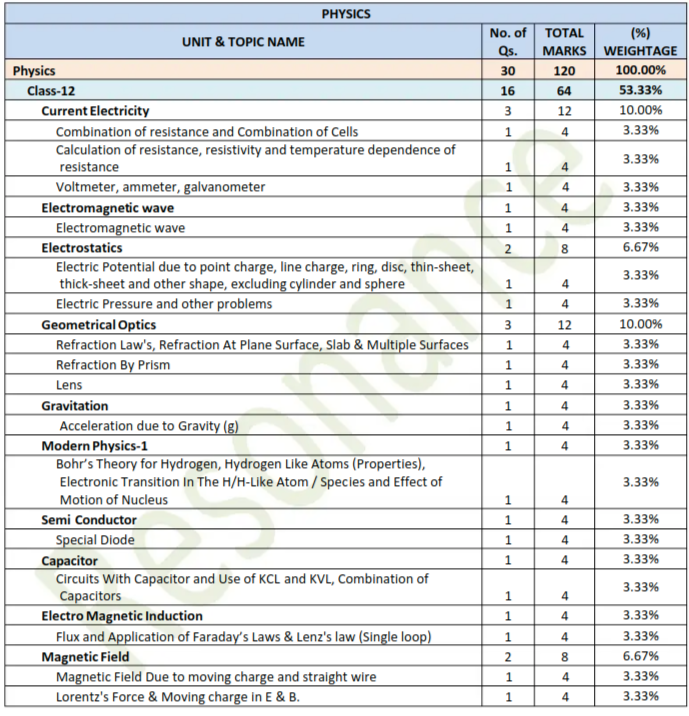
अध्याय | कांसेप्ट |
|---|---|
भौतिकी राशियां (Physical quantity) | |
इकाई प्रणाली (System of unit) | |
व्यावहारिक इकाइयाँ (Practical units) | |
विमीय (Dimension) | |
आवृत्ति, कोणीय आवृत्ति, कोणीय वेग, वेग प्रवणता (Frequency, angular frequency, angular velocity, velocity gradient) | |
किए गए कार्य की प्रकृति (Nature of Work Done) | |
परिवर्ती बल द्वारा किया गया कार्य (Work done by variable force) | |
गतिज ऊर्जा (Kinetic energy) | |
स्थितिज ऊर्जा (Potential energy) | |
वक्र स्थितिज ऊर्जा (Potential energy curve) | |
द्रव्यमान केंद्र (Center of mass) | |
ठोस शंकु के द्रव्यमान केंद्र की स्थिति (Position of centre of mass for solid cone) | |
द्रव्यमान केंद्र की गति (Motion of the centre of mass) | |
रेखीय गति एवं घूर्णी गति के समीकरण (Equations of Linear Motion and Rotational Motion) | |
बलाघूर्ण (Torque) | |
स्टोक्स का नियम एवं सीमांत वेग (Stokes' law & Terminal Velocity) | |
पृष्ठ उर्जा (Surface energy) | |
तरल पदार्थ की बूंद और साबुन के बुलबुले के अंदर अतिरिक्त दबाव (Excess pressure inside a liquid drop & soap bubble) | |
ऊष्मीय प्रतिबल तथा ऊष्मीय विकृति (Thermal stress and thermal strain) | |
ऊष्मा (Heat) | |
द्रव्य की अवस्थाएं (States of matter) | |
गैस के नियम (Gas laws(I)) | |
आदर्श गैस समीकरण (Ideal gas equation) | |
आदर्श गैस के गति के प्रकार (Various types of speeds of ideal gases) | |
आदर्श गैस की गतिज ऊर्जा (Kinetic energy of ideal gas) | |
विद्युतचुंबकीय प्रेरण और प्रत्यावर्ती धाराएं (Electromagnetic Induction and Alternating currents) | चुम्बकीय फ्लक्स (Magnetic flux) |
फैराडे का विद्युतचुम्बकीय प्रेरण का नियम (Faraday's law of Electromagnetic induction) | |
गतिक विद्युत वाहक बल (Motional Electromotive force(I)) | |
प्रेरक पर लागू एसी वोल्टेज (AC voltage applied to an inductor) | |
गतिक विद्युत वाहक बल (Motional Electromotive force(II)) | |
पोटेंशियोमीटर का उपयोग करके दिए गए दो प्राथमिक कोशिकाओं के ईएमएफ की तुलना (To compare emf of two given primary cells using potentiometer) | |
स्क्रू गेज का उपयोग करके दिए गए शीट की मोटाई का माप (To measure the thickness of the given sheet using screw gauge) | |
वर्नियर कैलिपर्स का उपयोग करके छोटे गोलाकार बेलनाकार पिंड के व्यास का माप (To measure the diameter of small spherical cylindrical body using Vernier Callipers) | |
अर्ध-विक्षेपण विधि द्वारा गैल्वेनोमीटर के प्रतिरोध का निर्धारण करना और इसकी फिगर ऑफ मेरिट का पता लगाना (To determine resistance of a galvanometer by half-deflection method and to find its figure of merit) |
उम्मीदवार जेईई मेन्स केमिस्ट्री 2026 के लिए सबसे अधिक वेटेज वाले अध्यायों की जांच कर सकते हैं ताकि पता चल सके कि किस विषय में उच्च अंक हैं। नीचे जेईई मेन में कार्बनिक, भौतिकी और अकार्बनिक रसायन विज्ञान का वेटेज दिया गया है। इसके अलावा, उम्मीदवारों को जेईई मेन्स में अकार्बनिक रसायन विज्ञान के वेटेज के बारे में पता चल जाएगा।
उम्मीदवार जेईई मेन में पिछले वर्ष के रसायन विज्ञान के वेटेज की जांच कर सकते हैं ताकि पता चल सके कि कौन से विषय सबसे महत्वपूर्ण हैं और उन्हें अधिक अभ्यास की आवश्यकता है। रसायन विज्ञान जेईई मेन्स वेटेज 2026 के लिए तालिका देखें:
जेईई मेन रसायन विज्ञान सिलेबस टॉपिक | प्रश्नों की संख्या | अंक |
|---|---|---|
अन्तर संक्रमण तत्व एवं उपसहसंयोजक रसायन (Transition Elements and Coordination Chemistry) | 3 | 12 |
आवर्त सारणी एवं निरूपक तत्व Periodic table and Representative Elements | 3 | 12 |
ऊष्मप्रवैगिकी और गैसीय अवस्था (Thermodynamics And Gaseous State) | 2 | 8 |
परमाणु की संरचना (Atomic Structure) | 2 | 8 |
रासायनिक आबन्ध (Chemical Bonding) | 2 | 8 |
रसायन एवं आयनिक साम्य (Chemical And Ionic Equilibrium) | 2 | 8 |
ठोस अवस्था तथा पृष्ठ रसायन (Solid State And Surface Chemistry) | 2 | 8 |
नाभिकीय रसायन एवं वातावरण (Nuclear Chemistry And Environment) | 2 | 8 |
मोल संकल्पना (Mole Concept) | 1 | 4 |
उपचयन व अपचयन अभिक्रियाएं (Redox Reaction) | 1 | 4 |
वैधुत रसायन (Electrochemistry) | 1 | 4 |
रासायनिक गतिकी (Chemical Kinetics) | 1 | 4 |
विलयनों के संपार्श्विक गुण (Solution and Colligative Properties) | 1 | 4 |
सामान्य कार्बनिक रसायन (General Organic Chemistry) | 1 | 4 |
त्रिविम रसायन (Stereochemistry) | 1 | 4 |
हाइड्रोकार्बन (Hydrocarbon) | 1 | 4 |
ऐल्किल हैलाइड (Alkyl Halides) | 1 | 4 |
कार्बोक्सिलिक अम्ल तथा उनके अवकलन (Carboxylic Acid and their Derivatives) | 1 | 4 |
कार्बोहाइड्रेट्स, एमिनो अम्ल एवं बहुलक (Carbohydrates,amino acid and Polymers) | 1 | 4 |
ऐरोमैटिक योगिक (Aromatic Compounds) | 1 | 4 |
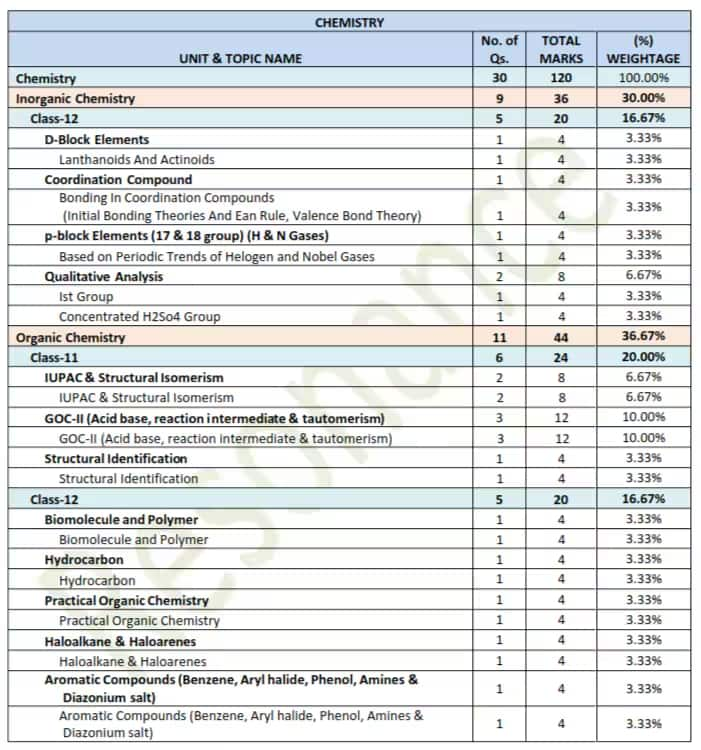
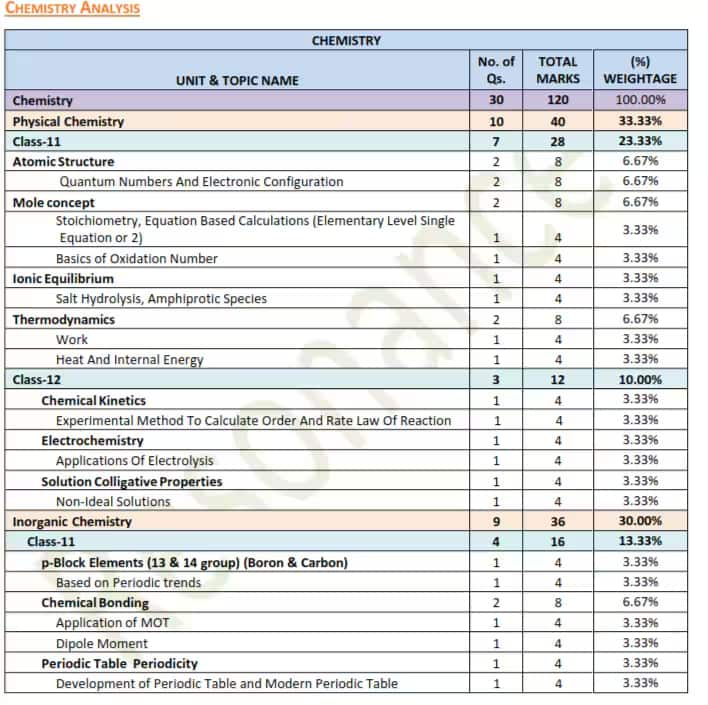
रसायन विज्ञान की बुनियादी अवधारणाएं (Some basic concepts in chemistry) | मुलानुपाती सूत्र एवं आण्विक सूत्र (Empirical Formula And Molecular Formula) |
मोल संकल्पना एवं मोल समूह (MOLE CONCEPT AND MOLAR MASS) | |
रस-रसायनमिति, स्तोईचिओमेट्रिक कैलकुलेशन एवं सीमांत अभिकर्मक (Stoichiometry, Stoichiometric Calculations And Limiting Reagent) | |
अभिक्रियाएं एवं विलयन (Reactions in Solutions) | |
प्रकाश विद्युत् प्रवाह (Photoelectric effect) | |
हाइड्रोजन के रेखीय स्पेक्ट्रम (Line spectrum of hydrogen) | |
त्रिज्या, वेग एवं बोहर nth कक्षा में ऊर्जा (Radius, velocity and the energy of nth Bohr orbital) | |
डेब्रोगली तरंगदैर्घ्य (Debroglie wavelength) | |
हाइजेनबर्ग अनिश्चितता सिद्धांत (Heisenberg’s uncertainty principle) | |
पथ, अवस्था फलन, प्रक्रिया के प्रकार (Path, State Function, Types Of Process) | |
प्रतिवर्ती, अपरिवर्तनीय, पॉलीट्रोपिक प्रक्रिया (Reversible, Irreversible, Polytropic Process) | |
ऊर्जा संरक्षण के नियम या प्रथम नियम (First Law Or Law Of Conservation Of Energy) | |
उत्क्रमित इज़ोटेर्मल एवं अनुत्क्रमित इज़ोटेर्मल (Isothermal Reversible And Isothermal Irreversible) | |
रुद्धोष्म उत्क्रमित तथा अनुत्क्रमित विस्तारण (Adiabatic Reversible And Irreversible Expansion) | |
अपचयोपचय अभिक्रियाएँ और विद्युत रसायन (Redox Reaction and Electrochemistry) | अपचयोपचय अभिक्रियाओं को संतुलित करना (Balancing of Redox Reactions) |
ऑक्सीकरण संख्या एवं ऑक्सीकरण अवस्था (Oxidation Number and Oxidation State) | |
अपचयोपचय अभिक्रियाओं के प्रकार (Types of Redox Reactions) | |
अपचयोपचय अभिक्रियाओं का संतुलन: आयन इलेक्ट्रोड विधि (Balancing of Redox Reaction: Ion Electrode Method) | |
असमानुपातन अपचयोपचय अभिक्रियाओं को संतुलित करना: आयन इलेक्ट्रोड विधि (Balancing of Disproportionation Redox Reaction: Ion Electrode Method) | |
स्क्रीनिंग प्रभाव एवं लैन्थेनाइड आकुंचन (Screening Effect and Lanthanoid Contraction) | |
परमाण्वीय त्रिज्या (Atomic Size/Radii) | |
आयनिकरण ऊर्जा (Ionisation Energy) | |
ऑक्सीकरण अवस्था (Oxidation State) | |
चुम्बकीय गुण एवं प्रकार (Magnetic Properties and Character) | |
योगात्मक यौगिक या आण्विक यौगिक (Addition Compounds or Molecular Compounds) | |
Terminologies Related to Coordination Compounds | |
लिगेण्ड के प्रकार (Types of Ligands) - 1 | |
ऑक्सीकरण संख्या (Oxidation Number) | |
उपसहसंयोजक संख्या (Coordination Number) | |
कार्बनिक यौगिकों की शुद्धि और विशेषता (Purification and Characterisation of Organic Compounds) | उर्ध्वपातन एवं क्रिस्टलीकरण (Sublimation and Crystallisation) |
कम दाब में आसवन और भाप आसवन (Distillation under reduced pressure and Steam distillation) | |
क्रोमैटोग्राफी (Chromatography) | |
हलोजन परीक्षण (Test for Halogens) | |
ड्यूमा विधि (Duma's Method) | |
कार्बनिक रसायन विज्ञान के कुछ बुनियादी सिद्धांत (Some Basic Principles of Organic Chemistry) | प्रकार्यात्मक समूह (Functional Group) |
आईयूपीएसी नामपद्धति (IUPAC Nomenclature) - 1 | |
कार्बोकेशन (Carbocations) | |
कार्बनियन्स (Carbanions) | |
एल्काइल फ्री रेडिकल्स (Alkyl Free Radicals) | |
हलोजन युक्त कार्बनिक यौगिक (Organic Compounds containing Halogens) | C-X बॉन्ड की प्रकृति एवं भौतिक गुण (Nature of C-X bond and Physical Properties) |
PCl5, PCl3, SOCl2 और HX प्रतिक्रियाएं | |
स्ट्रांग एवं वीक बेसेस (Strong and Weak bases) | |
SN2 अभिक्रिया | |
SN1 अभिक्रिया | |
ऑक्सीजन युक्त कार्बनिक यौगिक (Organic Compounds containing Oxygen) | ग्रीगनार्ड के अभिकर्मक (Grignard Reagent) - 1 |
Reduction by LiAlH4 and NaBH4 | |
अल्कोहल एसाइलेशन एवं ऑक्सीकरण (Acylation and Oxidation of Alcohols) | |
Reaction of Phenols with dil. HNO3 | |
एल्डिहाइड का निर्माण (Preparation of Aldehydes) | |
व्यावहारिक रसायन विज्ञान से जुड़े सिद्धांत (Principles Related to Practical Chemistry) | Preliminary Test with Dilute Sulphuric Acid (Systematic Analysis of Anions): |
धनायनों का विश्लेषण (Analysis of Cations) | |
रासायनिक आबंध और आणविक संरचना (Chemical Bonding and Molecular Structure) | Lewis Representation of Simple Molecules (Lewis Structure) |
अष्टक सिद्धांत की सीमाएं (Limitations of The Octet Rule) | |
बॉन्ड मापदंड: लंबाई, कोण, ऊर्जा, शक्ति (Bond Parameters: length, angle, energy, strength) | |
Fazan’s Rule and Covalent Character in Ionic Bond | |
p?-p? तथा p?-d? बॉन्डिंग (p?-p? and p?-d? bonding) | |
तत्वों का वर्गीकरण और गुणधर्मों में आवर्तिता (Classification of Elements and Periodic table) | आधुनिक आवर्त सारणी का दीर्घ रूप (Long form of Modern periodic table) |
तत्वों का वर्गीकरण : एस ब्लॉक (Classification of Elements : s-block) | |
तत्वों का परमाणु त्रिज्या (Atomic Radius of Elements) | |
परमाणु त्रिज्या के प्रकार आयनिक त्रिज्या (Variation of Atomic Radii and ionic radii) | |
Ionisation Enthalpy of Ionisation Potential |
जेईई मेन मैथ्स के लिए सबसे अधिक वेटेज वाले अध्याय हैं निर्देशांक ज्यामिति, सीमाएँ, निरंतरता और भिन्नता, इंटीग्रल कैलकुलस, और भी बहुत कुछ। उम्मीदवार पिछले वर्ष के जेईई मेन सिलेबस को नीचे दिए गए वेटेज पीडीएफ के साथ देख सकते हैं
| जेईई मेन सिलेबस गणित के टॉपिक | प्रश्नों की संख्या | अंक |
|---|---|---|
निर्देशांक ज्यामिति (Coordinate Geometry) | 5 | 20 |
सीमा, सांतत्य तथा अवकलनीय (Limits, Continuity and Differentiability) | 3 | 12 |
समाकलन गणित (Integral Calculus) | 3 | 12 |
सम्मिश्र संख्याएं और द्विघातीय समीकरण (Complex numbers and Quadratic Equation) | 2 | 8 |
आव्यूह एवं सारणिक (Matrices and Determinants) | 2 | 8 |
सांख्यिकी और संभाव्यता (Statistics and Probability) | 2 | 8 |
त्रिविमीय ज्यामिति (Three Dimensional Geometry) | 2 | 8 |
सदिश बीजगणित (Vector Algebra) | 2 | 8 |
समुच्चय, संबंध एवं फलन (Sets, Relation and Function) | 1 | 4 |
क्रमपरिवर्तन और संयोजन (Permutations and Combinations) | 1 | 4 |
द्विपद प्रमेय और इसके सरल अनुप्रयोग (Binomial Theorem and Its Application) | 1 | 4 |
क्रम तथा श्रृंखला (Sequences and Series) | 1 | 4 |
त्रिकोणमिति (Trigonometry) | 1 | 4 |
गणितीय तर्क (Mathematical Reasoning) | 1 | 4 |
अवकल समीकरण (Differential Equation) | 1 | 4 |
सांख्यिकी और संभाव्यता (Statistics and Probability) | 1 | 4 |
अवकलन आव्यूह (Differential Calculus) | 1 | 4 |
यहां हमने जेईई मेन (jee mains syllabus in hindi) में गणित का वेटेज प्रदान किया है। उम्मीदवार गणित के लिए जेईई मेन (jee mains syllabus in hindi) में गत वर्ष के वेटेज अध्याय की जांच कर सकते हैं।
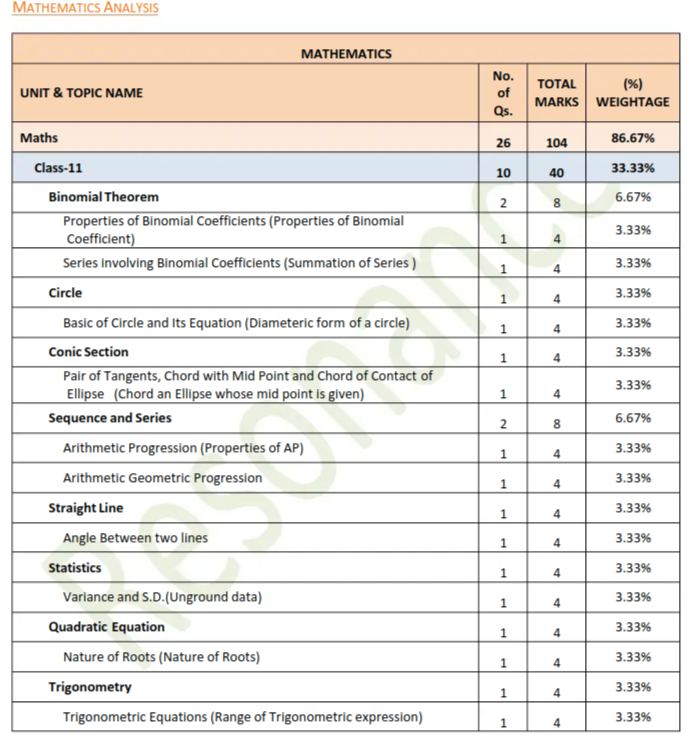
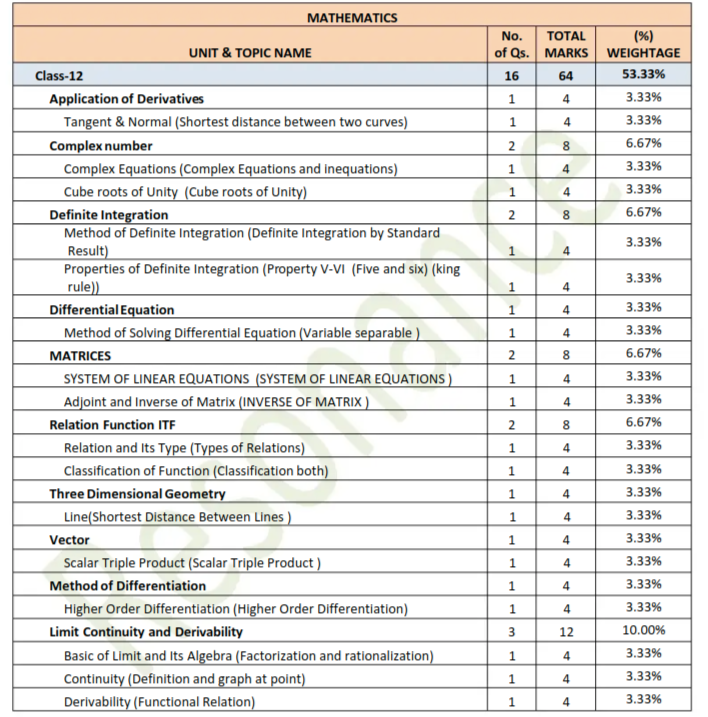
आगामी परीक्षा सत्रों के लिए अध्याय-वार जेईई मेन्स सिलेबस के साथ वेटेज 2026 (chapter-wise JEE Mains syllabus with weightage 2026 in hindi) भी उम्मीदवारों द्वारा सबसे अधिक खोजे जाने वाले प्रश्नों में से एक है। जेईई मेन 2026 (jee main syllabus in hindi) के महत्वपूर्ण विषयों में ज्यादातर एनसीईआरटी कक्षा 11 और कक्षा 12 के भौतिकी, रसायन विज्ञान और गणित विषयों के विषय शामिल हैं। परीक्षा में महत्वपूर्ण विषयों को जानने के लिए उम्मीदवार वेटेज के साथ जेईई मेन 2026 सिलेबस (JEE Main 2026 syllabus with weightage in hindi) की जांच कर सकते हैं।
Frequently Asked Questions (FAQs)
नहीं, जेईई मेन में शामिल हर विषय से प्रश्न पूछे जाएंगे। परीक्षा में प्रश्नों का निर्माण प्राधिकार पर निर्भर करता है; लेकिन विषयों के बीच ऐसी कोई समानता नहीं है।
छात्र यह समझने के लिए कि हाल के वर्षों में कौन से विषयों को कवर किया गया है, जेईई मेन पाठ्यक्रम से प्रश्नों का विषयवार वितरण वेटेज के साथ पा सकते हैं। इससे छात्रों को परीक्षा के लिए तदनुसार अध्ययन करने में मदद मिलेगी।
हां! जेईई मेन का आयोजन केवल ऑनलाइन मोड में किया जाएगा।
एनटीए जेईई मेन 2026 परीक्षा की तारीखों की घोषणा जल्द की जाएगी।
जेईई मेन्स में सबसे अधिक स्कोरिंग अध्यायों में भौतिकी से सरल हार्मोनिक मोशन और रोटेशनल मोशन (घूर्णन गति), रसायन विज्ञान के लिए हाइड्रोजन बॉन्डिंग और इलेक्ट्रोकैमिस्ट्री और गणित से कॉम्प्लेक्स नंबर व कैलकुलस शामिल हैं।
जेईई मेन 2026 परीक्षा तिथि जल्द जारी होंगी।
JEE Main 2026 का सिलेबस आधिकारिक वेबसाइट पर सूचना विवरणिका के साथ जारी किया जाएगा।
On Question asked by student community
Hello
If you want to get admission in IIT Delhi, then you will score well in JEE Advanced. Only the JEE Mains score is not sufficient to get admission in the IIT Delhi. You need to score 250+ marks for the general category in CSE. For the reservation category, you also need to score much higher marks and give your best performance. If you score quite well in JEE Advanced, then you will have a chance to get admission through JOSAA counselling.
Thank you
To score good marks in JEE Mains, you need a strong plan, consistent study habits and smart practice. First, finish the entire JEE syllabus from NCERT Class 11 and 12 textbooks, because these are the foundation for questions asked in the exam. After completing the basics, choose good quality reference books for Physics, Chemistry and Mathematics to build problem-solving skills and deepen your understanding. Make a weekly study plan where each day is divided into theory study, problem practice and revision of earlier topics.
Regularly solve previous years’ JEE Main papers and take timed mock tests to improve your speed and accuracy. Analyse every test you take, understand your mistakes and work on weak areas instead of only doing new questions. In subjects like Physics and Mathematics, practising a variety of numerical problems is important, while in Chemistry focus on concepts and reactions that are frequently asked. Revision is crucial, so dedicate time every week to revisit older topics and short notes that you make while preparing.
Stay consistent, avoid last-minute cramming, and maintain good health with adequate sleep and breaks during study. With disciplined planning, regular practice and careful revision, you can significantly improve your JEE Main score. All the best.
Achieving a JEE Rank of below 100 in JEE Main and Advanced 2027 requires a disciplined, two-year preparation strategy starting from Class 11. Your study plan must integrate competitive exam preparation with your school academics:
Syllabus Completion: Dedicate this year to rigorously completing the entire Class 11 NCERT syllabus for Physics, Chemistry, and Mathematics (PCM). Focus heavily on fundamental topics like Mechanics (Physics), General Organic Chemistry (GOC) and Chemical Bonding (Chemistry), and Calculus basics (Maths).
Concept Mastery: Do not rush. Master concepts thoroughly before moving to problems. Use standard JEE reference books and ensure you solve all NCERT examples and exercises first.
Practice: Allocate 60% of your study time to concept building and 40% to problem-solving. Practice JEE Main Previous Year Questions (PYQs) immediately after completing a chapter to gauge the exam pattern.
Advanced Topics: Complete the Class 12 syllabus by November 2026, focusing on high-weightage topics like Electrostatics, Modern Physics, and Electrochemistry.
Revision & Mocks: Reserve the period from December 2026 to January 2027 solely for mock tests and revision. Start taking full-length JEE Main mock tests (3 per week) under strict timed conditions. Analyze each mock test thoroughly to eliminate repeated errors.
Target JEE Advanced: After the JEE Main attempts in early 2027, shift focus entirely to JEE Advanced PYQs and challenging, multi-concept problems, taking at least 2 JEE Advanced mock tests per week.
A detailed subject-wise study plan and additional tips on effective JEE preparation starting from Class 11 can be found here: https://engineering.careers360.com/articles/jee-preparation-from-class-11
The last 30 days before the JEE Main exam should be dedicated entirely to revision, practice, and error analysis, shifting focus away from learning new concepts.
Here is a concise, 30-day study plan to maximize your score:
Prioritize High-Weightage Topics: Spend 70% of your revision time reviewing the most scoring and frequently tested chapters (e.g., Modern Physics, Chemical Kinetics, p-Block elements, Vectors & 3D Geometry). Use your short notes and flashcards for quick review, focusing on formulas, key mechanisms, and definitions.
Physics & Maths: Master all formulas and derivations. Practice at least 20 numerical problems daily, emphasizing speed and calculation accuracy.
Chemistry: Dedicate 50% of your Chemistry time to Inorganic (NCERT-based) and Organic (name reactions, reagents, mechanisms) concepts.
Daily Mock Test: Solve one full-length JEE Main Mock Test every day (3 hours) under strict exam conditions (9 AM–12 PM or 3 PM–6 PM).
Error Analysis (Crucial): Immediately after the test, spend 2-3 hours analyzing your performance:
Identify every incorrect or unattempted question.
Determine the reason for the error (Conceptual mistake, calculation error, or time pressure).
Revisit the concept from your notes/NCERT text to correct the mistake permanently.
Stop Learning New Topics: Absolutely avoid picking up new, complex chapters.
PYQ Sprint: Revisit only the last 3 years' JEE Main Previous Year Questions (PYQs). Mark any previously incorrect questions and solve them again.
Mindset: Focus on maintaining confidence, getting proper sleep, and using the revision breaks for physical activity to keep your mind fresh.
You can find more detailed subject-wise tips and psychological strategies here: https://engineering.careers360.com/articles/jee-main-preparation-tips
The most effective way to prepare for JEE Main 2026 is by focusing on the most important Previous Year Question Papers (PYQs), which highlight high-weightage and frequently repeated questions across Physics, Chemistry, and Mathematics. Since the exam strongly tests NCERT concepts, mastering these PYQs is essential for predicting the question pattern and improving your time management. https://engineering.careers360.com/articles/jee-mains-chapterwise-pyq-previous-year-questions-solutions-pdf
Among top 100 Universities Globally in the Times Higher Education (THE) Interdisciplinary Science Rankings 2026
Ranked #43 among Engineering colleges in India by NIRF | Highest Package 1.3 CR , 100% Placements
National level exam conducted by VIT University, Vellore | Ranked #16 by NIRF for Engg. | NAAC A++ Accredited
Recognized as Institute of Eminence by Govt. of India | NAAC ‘A++’ Grade | Upto 75% Scholarships
#6 All India Rank- IIRF Impact Ranking 2025 | H-CTC 24 LPA | Merit-Based Scholarships | Best of 2 Scores Advantage
Hands on Mentoring and Code Coaching | Cutting Edge Curriculum with Real World Application